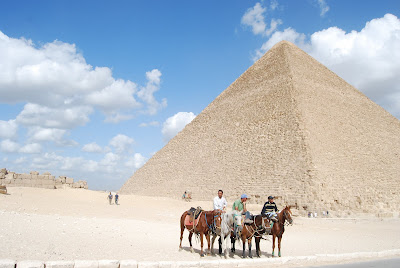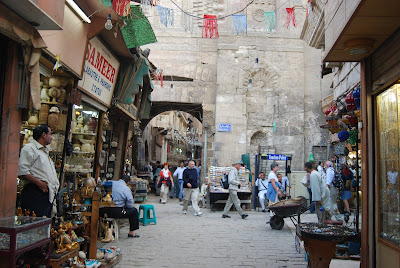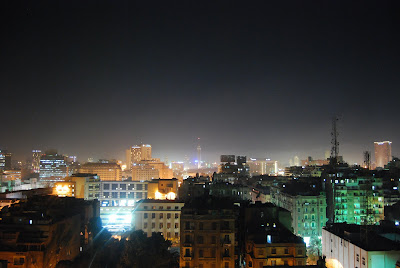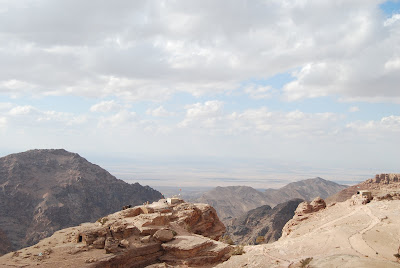












The Red Sea crossing between Aqaba in Jordan to Nuweiba in Egypt was slow and eventful (our ferry was drifting along the coast of Nuweiba aimlessly. There was something close to a riot on the boat as people were sick and tired of being left uninformed). In Nuweiba I had to wait for the bus to get full, I was getting a bit impatient and kept on going to the bus operator hassling them to start the engine. The tiredness of travelling since 5am was taking its toll on me.
I got to Cairo at 3am the next day. There were several taxi drivers trying to get me into their taxis but the competition wasn't so fierce and I was too tired to be cutthroat with my haggling. Paid a little bit more than I should for taxi to town but when I realised how far away I was from Downtown Cairo, I didn't mind. At 3am, Cairo was a serene place. Maybe it's good that I was spared the chaos during that desperate state of mind. I couldn't handle anymore stress!
By next morning, Cairo had awoken to its famous chaotic personality. The city streets roared with millions of cars, people and donkey carts. The shops and the sellers added to the symphony of light, color and noise. It was a truly exciting place. Downtown Cairo, where I stayed, was a beautiful district built in the late 19th-century in the image of Paris. Now the glamour is all but lost as the upper classes left for suburban dreams in the periphery of Cairo. But life goes on. The Beaux-Arts axial street plans had morphed into what seemed like a wide and colourful grand souq devoid of the orderliness and serenity of the European city of the 1930s. I have a soft spot for chaotic (but choreographed!) big cities with a mix of contradictions like London, Berlin and perhaps Istanbul so I fell in love with Cairo almost instantaneously. However this city is not for the fainthearted.
There are a lot of scams here. Whatever you're trying to buy or wherever you go, you have to take that extra precaution to double check what you're getting for and how much! You also need to learn to say NO in a decisive manner. On the way to the Pyramids, my taxi was stopped midway by a strange guy who then went on to say the road to the Pyramid is closed and somehow explained that I need to come with him on a donkey or something. By then I was more than prepared for such scams, I said no despite the aggressive persuasions and told the taxi driver to drive. Had he not driven me where I wanted to stop, I wouldn't have paid him a penny. Obviously the road to the Pyramids was fine and I got there without any problems. This kind of scams are so common in Egypt nowadays they have it in the travel guidebooks.
By now I have mastered how to deal with the sly and cunning ways of the Arab sellers. (If they say it's 100pounds, I'll say it's 2pounds, much to their disbelief). I let them assume that I either have the soft heart of the easily bullied Europeans or the moneyed and overly trusting Japanese tourist. Little did they know that Malaysians are ruthless hagglers and we are masters of deceit. We rarely let our sentiments or feelings known, so it's harder to deal with us. (Give the price, say NO! and walk away pretending not to care. Never smile).
What frustrated me the most was that I couldn't make sense of the streets in Downtown. I always got lost. In fact I got lost everyday - even with a map! I usually navigate with landmarks rather than remembering the streets. My brain function somehow dedicated less power to the lefts and rights in the directions. This worked in all other places so far but Downtown Cairo was probably the most confusing place for me. The streets all look the same, sound the same and have more or less same shops. The landmarks at each end of the road are the same as well because they all converge into one (somehow!). To make things worse, a lot of Arabs seem to have the problem of not being able to admit that they don't know something (especially the men). So I sometimes was sent to a wild goose chase all over the city. I was so angry with myself sometimes I lost the mood to do anything and just ended up sitting in any tea shop or internet cafe I saw.
There's always something to do in Cairo. Although not built during the Pharonic times, Cairo is an ancient city rich with history. The famous Pyramids are quite close by but they're in the neighbouring city of Giza. I did the Pyramids on my first day where I met the Aussie who came with me to Syria. It's very touristy here, needless to mention, but I was glad the tourists (euphemism for uninterested tour groups) stayed close to the Sphinx and left the rest of the vast area untouched. I took a horse ride (touristy! had to, it was really hot that day) to the area further into the desert to have a view of all three pyramids.
Egypt definitely understands the importance of its heritage. You can see how the regeneration projects in the historic areas are reaping the benefits from not just tourism but better quality of life for residents. I was surprised with the level of development in Egypt, it seemed like the country is growing quite rapidly. Compared to Syria and Jordan, constructions seem to be everywhere. Khan al-Khalili, or the "Islamic Cairo", was sensitively restored and now a pleasant strollable area. While retaining the clutter of the goods and chaos of the traditional Arab souq, it was devoid of the pollution and rubbish also typical of Arab cities. There are so many historic and beautiful mosques, madrasas and hamams in the whole district, you wonder no more why Cairo is called the city of thousand minarets.












